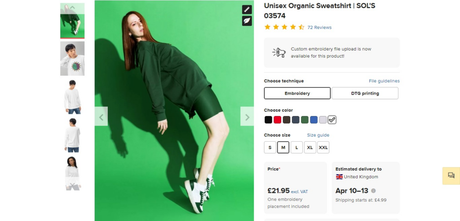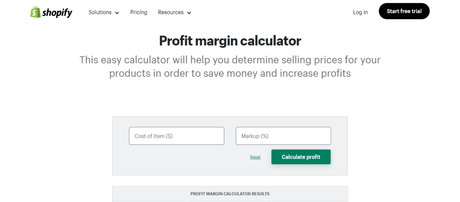Are you in the beginning phases of your POD business and need help with how to price your products? Or are you still doing your research, reading through our reviews of different print-on-demand platforms, and now wondering how to price everything?
Either way, it can feel somewhat overwhelming to arrive at this point. It's not always easy to get prices right when you're just starting out. After all, you neither want to price yourself too low and make a loss nor price products too high and forfeit sales.
So, to help with this, here's my guide on how to reasonably price print-on-demand products.
However, if you don't have time to read this entire blog post, here are my key takeaways:
- There's no set perfect price to go with
- You must calculate your total product costs (this figure factors in the cost of production, design, shipping, taxes, and any other business expenses). Then, be sure to include these expenses in your retail price.
- Monitor your competitors' pricing to ensure you're not wildly under or overcharging.
With that said, let's dive into the meat and potatoes of this guide:
What is Price Print-on-Demand?
First, let's ensure we're all on the same page about what print-on-demand (POD) actually is.
In short, POD is a branch of dropshipping where entrepreneurs typically use a print-on-demand platform to print their own design(s) onto products (apparel, homeware items, mugs, etc.). Then, when you make a sale, your chosen POD service handles order fulfillment - i.e., printing, packing, shipping, and sometimes customer service on your behalf.
The POD industry is projected to reach $39.87 billion by 2030. The attraction is that you only pay for what you sell, so there are no upfront costs or inventory storage outlay, making it an interesting option for entrepreneurs looking for a low-cost new business venture.
Having established that, let's walk through how to price print-on-demand products, step-by-step:
*For more information on what price print-on-demand is, check out this helpful glossary term.
Calculate Product Costs
By 'product costs,' I'm talking about the total amount it costs to create and sell your product.
Of course, this includes how much you pay for the production of each item (also sometimes known as the product's base price). These costs are often listed outright on your POD platform's product catalog. For example, the screenshot below shows that the base cost of Printful's unisex organic sweatshirt is £21.95 (Excluding VAT).

However, there are other expenses to factor in too:
Let's explore each of these in turn:
Design Costs
You might add your designs to products if you're an artist or an entrepreneur with creative flair. Alternatively, you might use some of the free designs available on your POD platform of choice. However, if you're hiring a professional designer, you need to consider their costs.
To calculate the design cost per item, divide what you pay the designer by the number of product items with the design you plan on selling, I.e.,
Design price ÷ the number of designs you plan to sell = design cost per product.If you're unsure how many designs you need to sell to cover the expense of your designer, use this equation.
Design price ÷ profit margin = minimum orders you need to sellAlternatively, if you're creating your own designs, remember to add the time you spend doing this. Consider: will this be time away from other aspects of your POD business, such as marketing? If you want to factor in your own design costs, try doing so with a realistic hourly rate for your work.
Here's the equation you'll need to compute your own design costs:
Your hourly rate x how long you spend on the design = the design priceShipping Costs
As mentioned, your POD platform takes care of shipping on your behalf. Typically, they'll offer a range of carriers like DHL, DPD, USPS, FedEx, etc.
In the case of Printful, it charges a flat shipping rate for each region and product. As for Printify, your chosen print provider determines shipping costs.
The bottom line: You'll need to determine how your POD partner calculates its shipping fees and factor this into your pricing strategy accordingly.
Remember: Nine out of 10 customers say free shipping is the highest incentive to shop online. So why not offer free shipping by adding shipping costs to your product's retail price? I.e.:
Your total product cost + your POD provider's shipping rate = your retail price with free shippingOf course, this means your product price will be higher. Still, considering the above statistic, it's worth considering or incentivizing customers to qualify for free shipping by setting a minimum spend. After all, 58% of consumers add more items to their cart to become eligible for free shipping.
Taxes
That dreaded word. There's no set amount here either, but your POD platform usually calculates tax depending on your customer's location. For example, it's VAT in the EU, UK, Liechtenstein, and Norway. In the US and Canada, it's Sales Tax, or GST, in New Zealand and Australia.
In the US and Canada, Sales Tax depends on your region and can vary from 5% to 15% in Canada. For US, it's 2.9% to 7.25%, but depending on the state, local governments sometimes impose a further sales tax of 1-5%.
You can't predict your tax rate until you know your customers' location. The best option is to further research this and/or speak to a local tax specialist. It's also worth looking at your POD platform's resource center to see what support they offer in this area. For example, Printful and Printify have guides on how it calculates and collects taxes.
Other Fees
Wherever you sell your items online, there will be fees involved. For example, Etsy charges a transaction fee of 6.5% of the total order amount and a $0.20 fee per product listing. Alternatively, if you're considering launching your own eCommerce store, you might be thinking about using a SaaS eCommerce platform to host your website - for instance, Shopify, Wix, BigCommerce, etc. If that's the case, don't forget to factor these monthly/annual subscription fees into your pricing system.
There are also payment processing fees to take into account. For example, PayPal charges between 1.2 to 2.9% transaction fee + a fixed fee depending on where you are and what currency you're trading in.
It's also worth noting that some POD partners offer premium plans you may wish to opt for. For example, Spocket's cheapest package at the time of writing is $24 a month (billed annually). With this cost, you benefit from perks that don't always come with free POD services. For instance, branded invoices, the ability to search for the products by images, and vetted suppliers.

Also, remember to factor in the cost of any advertising you might do, the cost of your Wi-Fi, and other business expenses.
Top Tip: The best way to factor these in is to take all your additional monthly costs and divide them by your profit margin. This figure will give you the minimum number of orders you'll have to sell each month to break even on these expenses.
Additional monthly costs ÷ your profit margin = minimum orders you have to sell each monthHaving made that calculation, if you think it's unrealistic, i.e., way too high or even too low, then play around with the figure. Remember, your retail prices aren't set in stone. You have the freedom to test what works and optimize your pricing strategy accordingly.
The moral of the story: Familiarize yourself with all the above fees and, most importantly, add them to your retail price.Calculate Your Profit Margin
So, with the above costs outlined, here's how to ensure you make money from your POD venture.
Firstly, it's worth looking at how much competitors are selling the same/similar items so you don't underprice. Ideally, you want to match their prices or even undercut them. However, it's essential to be realistic. In other words, there's no point in selling 15% or 20% above what everyone is selling. However, if you fancy the challenge of charging more for products, you'll need to justify this by offering better value for money. For example, free shipping, freebies, superior customer service, loyalty schemes, etc. Feel free to get creative!
When conducting your competitor/market research, head to Google Trends to get a sense of how product prices have historically fluctuated, what the demand for your product is, and whether prices typically change seasonally. With this information in hand, you'll be better positioned to set a reasonable profit margin.
Pro Tip: Look at competitor reviews to gauge how shoppers feel about their product prices. Then, be sure to take these opinions into account when setting your profit margins.
To help you decide on your profit margin, Shopify has a helpful profit margin calculator worth playing around with.

Elsewhere, Printify recommends a profit margin of 40%, while Printful recommends 30%.
Once you've decided how much profit you want to make, e.g., 25%, just add it to the total cost of your product. This figure will give you your retail price. Easy, right?
Just remember to keep an eye on what your competitors are doing. For example, suppose your niche is women's eco-friendly apparel, and you notice your competitors have altered their prices. In that case, you may also want to follow suit and adjust your profit margin to stay ahead of the curve.
Pricing Strategies
As I've just mentioned, it's important to remember this process is a work in progress, i.e., it's not static. For example, your POD platform may raise or reduce the cost of individual items, or state/country sales taxes may increase or decrease. In such instances, you'll have to amend your pricing strategy accordingly.
That said, there are a few tricks to keeping your prices competitive:
Consider Discount and/or Anchor Pricing Strategies
As you've probably already guessed, this is when you offer pricing discounts/coupon codes. For example, regular and/or holiday sales like Black Friday attract more customers eager for a bargain. This is a strategy worth toying around with because sometimes, once you've enticed shoppers onto your website (thanks to your discount), they'll stick around to peruse and purchase other items. This isn't surprising, considering that research suggests that in 68% of instances, discount coupon codes boost brand awareness and customer loyalty.
Similar to, but not to be confused with, discount pricing is anchor pricing. This marketing technique establishes an 'anchor price' for a product, e.g., a hoodie for $40. Customers can clearly see this price and, next to it, the discount you have applied, creating the illusion that they're getting a bargain. So your $40 hoodie price is showing, but next to it is your "discounted" price of $30. This technique is regularly used to trigger a response in consumers to encourage them to buy.
Focus On Getting the Ball Rolling
If you want to attract a customer base quickly, especially if you're entering the market, you could start by offering lower prices to attract customers. Then, gradually increase your costs as you gain a loyal following.
Dynamic Pricing
This is also sometimes referred to as demand pricing, surge pricing, or time-based pricing. In short, it's when you adjust your prices according to outside influences. For example, in Winter, the demand for warmer clothes is higher, so you push the prices of relevant products.
This pricing strategy might be right for your business if you're able to accurately gauge how and when the demand for your product will shift. Perhaps you have sales data from previous years you can use to forecast sales and plan product price points accordingly?
You may also want to consider dynamic pricing if competitors in your industry are adopting this pricing model. If they've validated that demand pricing works and is accepted by customers in your niche, you don't have as much to risk by testing it out yourself.
How to Price Print-on-Demand Products: My Final Thoughts
So that's all for my guide on how to price print-on-demand products. I hope you have a clearer idea of how to approach your pricing strategy.
If you take the time to factor in all your costs (as listed above) and add them to your retail prices, you shouldn't go wrong!
Ready to start setting prices for your price print-on-demand products? Good luck! Don't forget to tell me how you get on in the comments box below!
ecommerce growth strategyecommerce strategyprice analysis
